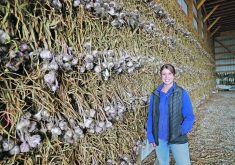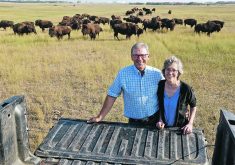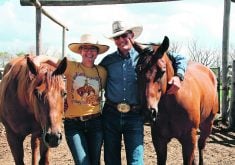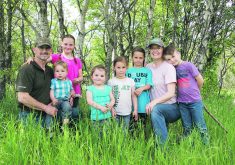CARBERRY, Man. — Casting a quick look around Gerry Oliver’s kitchen and living room, it’s easy to spot at least a dozen items related to sheep.
There are sheep photos on the fridge, ceramic tiles with sheep images, sheep hides hanging over chairs, trophies for best fleece, books on Canadian sheep history and plastic bags filled with wool on chairs.
Despite all the paraphernalia, Oliver is no fanatic.
Sitting at the kitchen table of her farmhouse north of Carberry, Man., Oliver shared her passion for sheep and wool.
Read Also

Fuel rebate rule change will affect taxes and AgriStability
The federal government recently announced updates to the fuel rebates that farmers have been receiving since 2019-20.
Oliver grew up in Ottawa, where she had no connection to farm life, but became interested in wool as a young adult.
“I was a rug hooker,” she said, gazing out windows framing the Trans-Canada Highway in the distance.
After training as a lab technician, Oliver took a job with the federal government in Kingston, Ont. She met Ralph Oliver from Carberry, who had a term position in the same government office.
Following their courtship, Gerry quit her job and moved to Ralph’s family farm in Manitoba.
“I always wanted to live on a farm,” said Oliver, who was fascinated by horses and animals as a child.
Ralph’s family had moved out of livestock and were operating a grain farm. But two decades ago, the Olivers expanded the farm, buying a tract of land under cultivation and some pasture.
They decided on sheep after meeting members of the Manitoba Sheep Association at a grazing school.
Oliver’s interest in rug hooking broadened into a passion for sheep and wool production. She maintains a blog called www.all-things-wool.ca and even created an art exhibit with a sheep theme.
Oliver documented a year in the life of a sheep producer, painting scenes like feeding, shearing or herding sheep.
The exhibit, called a Shepherd’s Diary, has been shown at galleries in Manitoba and Saskatchewan.
Today, Oliver has more time for art because the couple rents most of their farmland.
She now dedicates most of her time to her sheep herd, having developed a fondness for rare breeds.
Oliver raises several long wool breeds, including Romney, Cotswold and Wensleydale.
“The Wensleydales, there are only like three dozen in the country.”
Oliver added Wensleydales in the fall of 2014 because the British breed produces one of the finest long wools in the world.
In a pen behind the farmhouse, Oliver haltered a docile Wensleydale named Margaret.
“The wool, it’s almost like a little chain of pearls. It’s very beautiful,” Oliver said. “Most wools aren’t like that.”
Delia Burge raises Wensleydale sheep in Scotsburn, N.S. She said the wool from Wensleydales is unrivalled.
“I’ve been a spinner and a weaver and have worked with wool for 40 years. It definitely is the ultimate in sheep’s wool,” she said. “The closest fibre would be mohair because it has such an incredible sheen.”
Oliver sells her wool directly to fibre artists and crafters, who want to work with high quality and unique wool fibres. Demand is strong thanks to revived interest in traditional crafts like spinning, weaving and fibre art.
“I can sell my fleeces, individually, for many times what I would get for my wool if I sold it (through) the wool co-operative,” Oliver said, noting most fleece is sold at about 60 to 70 cents a lb.
“I can sell one fleece, for, on average $40 to $50…. And the Wensleydales are a lot more then that.”
Oliver also sees an opportunity to crossbreed her rare sheep with more common sheep to breed offspring that are productive for meat and wool.
Burge and Oliver both said that too many sheep producers focus on meat production and completely forgo wool.
“In the larger, commercial flocks, a lot of them dump their wool in the woods,” Burge said. “They just can’t be bothered to deal with it.”
Oliver hopes to persuade Canadian sheep producers to do both.
“I want to say by using these long wools, or rare breed, to cross… they can produce high quality meat… and (garner) the extra money the wool can generate.”
Contact robert.arnason@producer.com
















